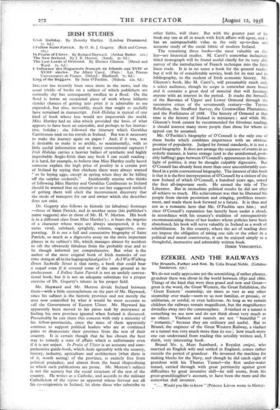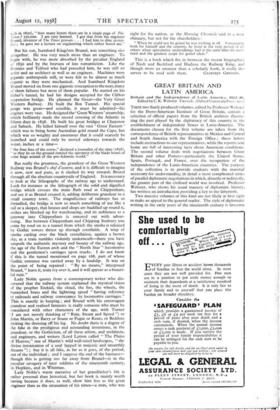EZEKIEL AND THE RAILWAYS
The Brunels, Father and Son. By Celia Brunel Noble. (Cobden.,
' Sanderson. 15s.) _ . • •
WE do not really appreciate yet the astonishing, if rather phoney, grandeur there was about in the world between 183o and 1860. Things of the kind that were then grand and new and Great— great is the word, the Great Western, the Great Exhibition, the ' Great Eastern ' steamship, six times as vast as any other steamship ever made—seem to us now familiar, or prosaic, or utilitarian, or sordid, or even ludicrous. As long as we remain children the railways remain magnificent, but the magnificence dwindles away into the commonplace. A viaduct or a tunnel is something we use now and do not think about very much as an object. Viaducts and tunnels are not " beautiful " or " romantic," because they are ordinary and useful. • But to Brunel, the engineer of the Great Western Railway, a viaduct or a tunnel was very much more than its use ; how much more one can understand from reading this sensibly written and, I think, very interesting book.
Brunel No. z, Marc Isambard, a Royalist emigre, 'who married an English wife and settled in England, comes rather outside the period of grandeur. He invented the machine for making blocks for the Navy, and though he did catch sight of grandeur with his Thames Tunnel—the first under-water tunnel, carried through with great pertinacity against great difficulties by great inventive skill—he still seems, from his great-granddaughier's account, to have been the mere and the somewhat dull inventor.
" . Would you like to know" (Princess Lieven wrote to Metter- <
n;ch in 582o), " how many letters there are in a single page of The Times? 250,000. I am very learned. I got that from the engineer Brunel, inventor of The Times presses . . . I had him to dine yester- day ; he gave me a lecture on engineering which rather bored me."
But his son, Isambard Kingdom Brunel, was something else altogether. He was very much more than an engineer. To begin with, he was more absorbed by the peculiar England of 1830 and by the bravura of late romanticism. Like the Rennies and Telford who had preceded him, he was still an artist and an architect as well as an engineer. Machines were gigantic anthropoids still, or were felt to be almost as much organic as they were mechanical. And Isambard Kingdom Brunel moved on from one gigantic conception to the next, many of them failures but most of them popular. He started on his father's tunnel, he had his designs accepted for the Clifton suspension bridge. He planned the Great—the Very Great Western Railway. He built the Box Tunnel. His special gauge was great—and sensible, it must be admitted—his engines were vast. He designed the ' Great Western' steamship, which brilliantly made the record crossing of the Atlantic in fifteen days in 1838. He built his great bridges at Chepstow and Saltash. He killed himself over the vast ' Great Eastern ' which was to bring home Australian gold round the Cape, but which was so weighty and enormous that it could scarcely be launched and could only be moved sideways towards the water, inches at a time- " the four fans of the screw," declared a journalist of the time (1858), " as they lie on the ground remind the spectator of the blade bones- of some huge animal of the pre-Adamite world."
But really the greatness, the grandeur of the Great Western Railway was Brunei's chef d'oeuvre, and it is difficult to imagine it now, new and pure, as it slashed its way towards Bristol through all the absolute countryside of England. It is necessary to look at the lithographs of the railway age to understand. Look for instance at the lithograph of the solid and dignified bridge which crosses the main Bath road at Chippenham, and see it as Brunel created it, adding deliberate grandeur to a small country town. The magnificence of railways has so dwindled, the bridge is now so much something of use like a rail or a sleeper, that houses and shops are huddled up round it, arches are blocked up for warehousing, and its nobleness as a gateway into Chippenham is smeared out with adver- tising. But between Chippenham and Chipping Sodbury you come by road on to a tunnel from which the smoke is released by Gothic towers thrust up through cornfields. A wisp of smoke curling over the black crenellation, against a brown sky, as a train rumbles violently underneath—there you have unspoilt the authentic mystery and beauty of the railway age, the age of the Euston arch and the " North Star " locomotive and the gentlemen's carriages upon trucks. I do not know if this is the tunnel mentioned on page 168, part of whose
Gothic, entrance was carried away by a landslip. It was on the point of being repaired : " By no means," interposed
Brunel, " leave it, train ivy over it, and it will appear as a beauti- ful ruin."
Lady Noble quotes from a - contemporary writer who dis- covered that the iailvaay System explained the mystical vision of the prophet Ezekiel, the cloud, the fire, the wheels, the burnished brass and the lightning speed " having reference to railroads and railway conveyance by locomotive carriages." This is exactly in keeping ; and Brunel with his extravagant grandeur and realised fantasies is really someone who must be considered with other characters of the age, with Turner (I am not merely thinking of " Rain, Steam and Speed ") or John Martin, or Barry or Soane or Pugin or Keats, or Beddoes picking the dressing off his leg. No doubt there is a degree of the fake in the prodigious and astounding inventions, in the grandeur, or the Gothicism, of all these artists, and architects,
and engineers, and writers (Lord Lytton called " The Plains of Heaven," one of Martin's wild wall-sized landscapes, " the divine intoxication of a soul lapped in majestic and unearthly dreams ") ; but it is all fake, as far as it goes, of the period, not of the individual ; and I suppose the end of the business—
though this is getting too far away from Brunel—is in the peculiar savagery of later oddities of the nineteenth century, in Hopkins, and in Whitman.
Lady Noble's warm narrative of her grandfather's life is rather personal than historical, but her book is mainly worth having because it does, as well, show him less as the great engineer than as the emanation of his times—a man, who was right for the nation, at the Morning Chronicle said in a wise obituary, but not for the shareholders : " When he could not be grand he was nothing at all. Fortunately both for himself and the country, he lived at the very period of others when speculative undertakings had at the same time the most need and the greatest scope for grand ideas."
This is a book which fits in between the recent biographies of Nash and Beckford and Hudson the Railway King, and though more an amateur than a scholarly book, it really de-







































 Previous page
Previous page